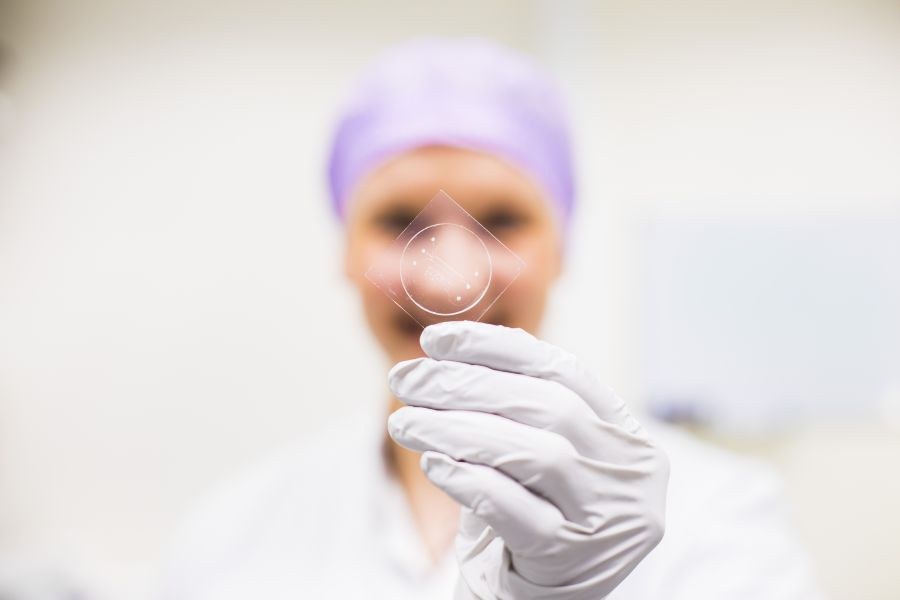A new research model for studying obese fat tissue – Alma Yrjänäinen is motivated by popularising her field

Alma Yrjänäinen works as a doctoral researcher in the Adult Stem Cell Research Group at Tampere University, which is part of an Academy of Finland-funded Centre of Excellence (CoE). The aim of the group is to create a three-dimensional study model for obesity. The model can be used to investigate obese fat tissue and its function.
According to Yrjänäinen, the current research models for fat tissue are rather simple and not suitable for studying, for example, the function of the whole tissue or different cell types. There is thus a need for a broader and more comprehensive study model to take research on obesity to the next level.
“Fat tissue is made up of many different building blocks, i.e. different cell types and connective tissue. If we study only one type of building block, i.e. one cell type, we completely miss the effect of all the other different cell types in the tissue,” Yrjänäinen says.
According to Yrjänäinen, instead of studying just one cell type, the goal of the project is to develop a microscopic, three-dimensional tissue model that will include more cell types and physical structures. In other words, the aim is to build eg a functional vascular network to study how different biological elements communicate within the adipose tissue.
“The function of overweight fat tissue is very diverse because it is, for example, in a constant state of low-grade inflammation adding up even more elements that affect the tissue functionality. In our study model, we try to bring all these different elements together,” Yrjänäinen explains.
“Our aim is to be able to study the interactions between eg adipose cells, vascular cells and inflammatory elements in the tissue. Our model will allow us to do this in a controlled environment that enables reflecting the real situation in the human body much better,” Yrjänäinen says.

Obesity research is becoming increasingly important
The global overweight population keeps growing. It is important to develop research methods for obesity because of, among other things, the many comorbidities associated with the condition. For example, overweight predisposes people to type 2 diabetes and cardiovascular diseases.
Yrjänäinen says that the research model developed in the Adult Stem Cell Group is important for obesity research because, for example, it corresponds better to the real situation in the human body than the existing research models. For example, animal models have been used in obesity research. However, using the old methods to interpret the results more broadly in terms of entire tissue function is problematic due to the different diets and body functions of humans and animals.
“The ethical considerations related to animal testing are also a big motivator for me. The aim is to reduce animal testing and to develop alternative technologies for research. Our study model will eventually allow us to offer a dynamic human tissue model alternative for obesity research,” Yrjänäinen mentions.
Popularising research is important
Yrjänäinen thinks that in addition to conducting research, it is important for researchers to be able to communicate their research topics understandably to people outside the academic community.
That is why Yrjänäinen participated in the Three Minute Thesis (3MT) competition in January 2021. In the Three Minute Thesis contest, the competitors pitched their research topics concisely in lay terms (watch Yrjänäinen’s pitch on YouTube). After advancing to the finals and winning the internal vote for the best presentation at Tampere University, Yrjänäinen was given the opportunity to participate in the Millennium Pitching Contest pre-qualifiers to pitch her research topic.
According to Yrjänäinen, the process of learning to pitch and summarising and popularising her research topic was challenging and time-consuming but rewarding.
“Through learning to pitch, I have come to understand the difference in the way I need to talk about my research to different people. You must always use a language the audience understands,” Yrjänäinen summarises.
According to Yrjänäinen, popularising academic research is important because scientific research results belong to all, not just to the researchers. Popularisation enables showing why research is important and necessary for society. Yrjänäinen also believes that it is important to work actively to popularise academic research because it creates a sense of inclusion and offers new insights.
“In the popularisation of research, you must often cut corners, which may raise fears of being misunderstood. However, one should not be too afraid of making mistakes or strive for perfection. The most important thing is to try to do your best,” Yrjänäinen says.
“Even though there may be a risk of misunderstanding, it is still a worthwhile risk to take compared to not popularising research at all,” she says.
Text: Nelli Peltonen
Photographs: Jonne Renvall
Contact person
Alma Yrjänäinen
Student, Doctoral Research Alma Yrjänäinen
Alma Yrjänäinen




